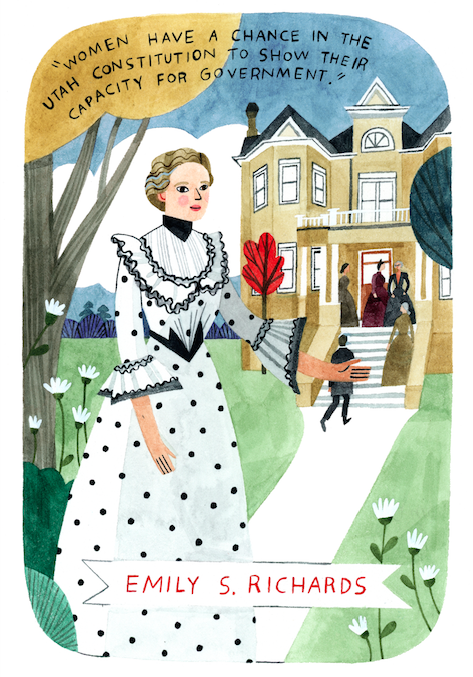
Emily S. Richards,
A Believer in Suffrage
1850-1929
“Women [now] have a chance in the Utah constitution to show their capacity for government.”
By Andrea Radke-Moss

Emily S. Richards. Photo courtesy of Bruce J. Nelson
Born on May 13, 1850, Emily Sophia Tanner gained her first sympathies for women’s rights at home, later describing how she “had always been a believer in suffrage, for upon her were not wasted the early opinion of her spirited pioneer mother.” [1] Emily was also influenced by one of her schoolteachers, the renowned LDS Relief Society leader and suffragist Sarah M. Granger Kimball.
In 1868, Emily married Franklin S. Richards, and found herself in a supportive family climate for growing her ideals of woman’s equality. [2] Her parents-in-law, Franklin D. and Jane S. Richards, were influential church leaders and supporters of woman suffrage. Jane also served on the Deseret Hospital board, alongside Emmeline B. Wells, Eliza R. Snow, and others who mentored Emily’s own suffrage activism.
As Congress ramped up its anti-polygamy legislation in the 1880s, Emily joined a new generation of monogamous Mormon suffragists, attending suffrage meetings alongside national leaders such as Susan B. Anthony and Elizabeth Cady Stanton. These associations, wrote Emily’s fellow suffragist Annie Wells Cannon, “broadened her vision and gave her a perspective of woman’s place in the world’s work not to be gained in any other way or by any amount of study.” [3] Emily’s service in the Relief Society expanded her leadership skills, too. Relief Society General President Eliza R. Snow once counseled her, “When you are asked to speak again, try and have something to say.” [4]

Emily S. Richards. Photo courtesy of Bruce J. Nelson
Emily emerged as a standout speaker, organizer, and the public face of Utah suffrage. She and Margaret Caine organized the Utah Woman Suffrage Association on January 10, 1889, and attended their first National Woman Suffrage Association meeting that year in Washington, D.C.
Emily then created local suffrage associations in conjunction with local Relief Societies throughout Utah and the intermountain West. By 1891, Utah women were welcomed into membership in the International and National Councils of Women (ICW and NCW). Emily had many opportunities to represent Utah at ICW and NCW meetings, most notably at the Chicago World’s Columbian Exposition and the World’s Congress of Representative Women in 1893.
As Utah moved closer to statehood in the mid-1890s, both Emily and Franklin threw themselves into the cause of ensuring that equal suffrage be included in the proposed state constitution. When this goal was achieved, they hosted the celebratory visits of national suffrage leaders, including Susan B. Anthony, in their home in Salt Lake City.
“Women have a chance in the Utah constitution to show their capacity for government, and help mold the institutions of society,” Emily said of the achievement. “The work is but begun; the cause is in its merest infancy. That which remains to be done opens up before us in an almost endless vista. In a far away promised land we behold a perfected state wherein the heart and hand and intelligence of woman contribute their full share.” [5]

Emily and Franklin S. Richards. Photo courtesy of Utah State Historical Society
Even after Utah achieved women’s suffrage rights through statehood in 1896, Emily continued her support of a national suffrage amendment as a member of the Utah State Council of Women. She acted as a delegate to the 1904 ICW conference in Berlin, and the Toronto Conference in 1909. Though Emily participated in other charitable and reform work, equal suffrage for Utah and American women remained her greatest achievement. “This was purely a work of devotion to the suffrage cause: Utah women had gained their victory, but for the women in other states Mrs. Richards still carried on.” [6] She died in 1929, nine years after the ratification of the 19th Amendment to the U.S. Constitution.
Andrea Radke-Moss is Professor of History and Associate Dean of Faculty Development for the College of Language and Letters at Brigham Young University-Idaho.
Footnotes
[1] Annie Wells Cannon, “In Memoriam: Emily Sophia Tanner Richards (Salt Lake City, UT: n.p., 1929),” 15.
[2] Emily missed being able to vote in Utah’s first election open to women, since she was not yet twenty-one years old.
[3] Cannon, “In Memoriam,” 11-12.
[4] Emily S. Richards, “General Conference Relief Society,” Woman’s Exponent 30, no. 7 (December 1, 1901): 54; quoted in Andrea G. Radke-Moss, “Truly Her Soul Rejoiced in Helping the Helpless,” in Richard E. Turley, Jr. and Brittany A. Chapman, eds., Women of Faith in the Latter Days, Volume III: 1846-1870 (Salt Lake City: Deseret Book, 2014), 134.
[5] Emily S. Richards, “Woman Suffrage in Utah,” Deseret News [Weekly], February 15, 1896; reprinted in Collected Discourses: Delivered by President Wilford Woodruff, his Two Counselors, The Twelve Apostles, and Others, 1886-1898, ed. Brian H. Stuy, vol. 4 (Burbank, CA: B.H.S. Publishing, 1991), 419-423. Also reprinted in Radke-Moss, “Truly Her Soul Rejoiced . . .,” in Women of Faith, Vol. III, pp. 140-141.
[6] Cannon, “In Memoriam,” 16-17.

